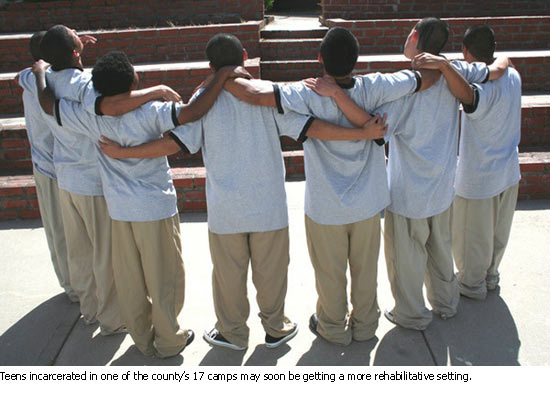A new tack for old juvenile camps
March 1, 2011
 Helping a troubled adolescent isn’t easy. Even more difficult is helping a hundred of them in one room, at the same time. That, however, has been the challenge for the Los Angeles County Department of Probation, which houses some 1,300 young offenders in its juvenile detention camp system.
Helping a troubled adolescent isn’t easy. Even more difficult is helping a hundred of them in one room, at the same time. That, however, has been the challenge for the Los Angeles County Department of Probation, which houses some 1,300 young offenders in its juvenile detention camp system.
Research has shown that the most effective programs take place in small group settings. But the county’s 17 camps, many built decades ago, still feel more like military camps than places where a troubled kid might be rehabilitated—little room for study and introspection, but plenty of space for power struggles and gang fights.
On Tuesday, the Board of Supervisors took a first step toward giving Los Angeles County’s juveniles a more rehabilitative setting. Acting on a motion by Supervisors Zev Yaroslavsky and Don Knabe, the board voted to pursue a $28 million state grant to transform one the county’s 17 camps into a state-of-the-art rehabilitative compound.
“This is a modest attempt to change the dynamics in one camp and the outcomes in one camp, so hopefully we’ll learn a few things and begin to convert other aspects,” Yaroslavsky said. “We’ve got to do something about these camps.”
Although the supervisors are examining which camp to refurbish, the county’s grant application was clear on the goal—to create a more therapeutic model by replacing the old, military-like settings with smaller cottages and more intimate areas for dining and meeting.
“Right now, it’s like a teacher trying to teach a classroom with 50 kids rather than 20,” said the probation department’s chief deputy, Cal Remington. “We’re trying to get these kids to think positively about what we’re trying to teach them. But it’s hard for them to think about anything but each other and status in these big settings.”
Evidence, he said, has repeatedly shown that troubled adolescents are much more likely to change their behavior and attitude when they’re housed as small groups. “A lot of people like the idea of boot camp, but the evidence shows that they don’t change behavior. They just force some kids to say, ‘Yes sir’ and ‘No sir’.”
Jackie Caster, a Los Angeles youth advocate who, like many, has been pushing for some time for improvements to the county’s troubled and outdated juvenile detention program, said changing the layout of the detention camps is crucial.
A year and a half ago, Caster said, she and a number of county officials and academics visited Missouri, where the effectiveness of the juvenile justice system has been held up as an example nationwide. Although comparisons between the rural Midwest and urban Los Angeles are tricky, both she and Remington said that Missouri’s costs and recidivism rates appear to be much lower than L.A.’s.
The secret, Remington said, lies in calmer, more intimate settings that force the juveniles to engage with staff and peers one-on-one. In Missouri, he and others said, the teenagers are put into smaller group homes, given intensive individual and family therapy and academic instruction and taught teamwork and conflict resolution.
Rooms built for small group interaction allow for more counseling and better treatment. The Missouri camps, Caster said, “don’t look like institutions. They have carpets on the floor, pictures on the walls. The kids have bunks and closets. They’re made to feel valued, not just institutionalized.”
The grants are authorized by the state’s 2007 Juvenile Justice Reform Bill, which shifted California’s non-violent juvenile offenders into county programs and facilities. As part of that measure and subsequent legislation, the state authorized some $300 million in lease-revenue construction bonds for the design and construction of new or renovated county facilities for youthful offenders.
Los Angeles County’s proposal is not the largest to have been approved under the program. Alameda County is planning to build a similar 150-bed girls’ camp for $35 million. Still, several supervisors expressed concern that the grants might fall through, given the state’s financial problems. Also the program requires that the county ante up a $2.8 million cash match, plus a 15% contribution of in-kind services such as architectural planning.
Robert J. Takeshta, deputy director of the California Corrections Standards Authority, which administers the program, said that if the county sets the paperwork in motion, it could still decline the grant if the supervisors decided not to go through with the project. The money, he says, would simply go back into the pot to fund another juvenile justice project elsewhere in the state.
Said Supervisor Knabe: “Why leave money on the table when we have the ability to pull the plug if we want to?”
Posted 3/1/11












 405 bridge work causes a stink
405 bridge work causes a stink
